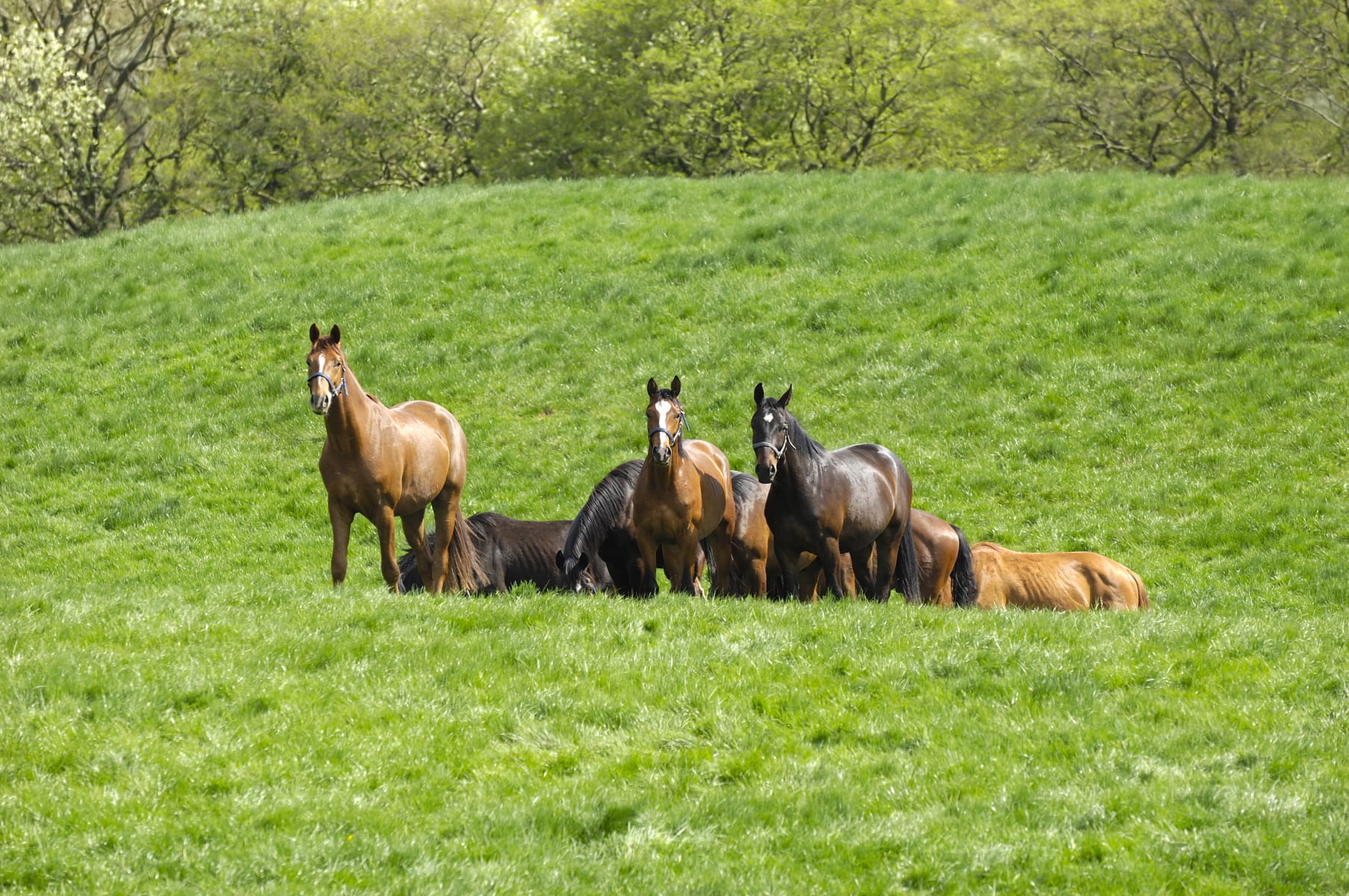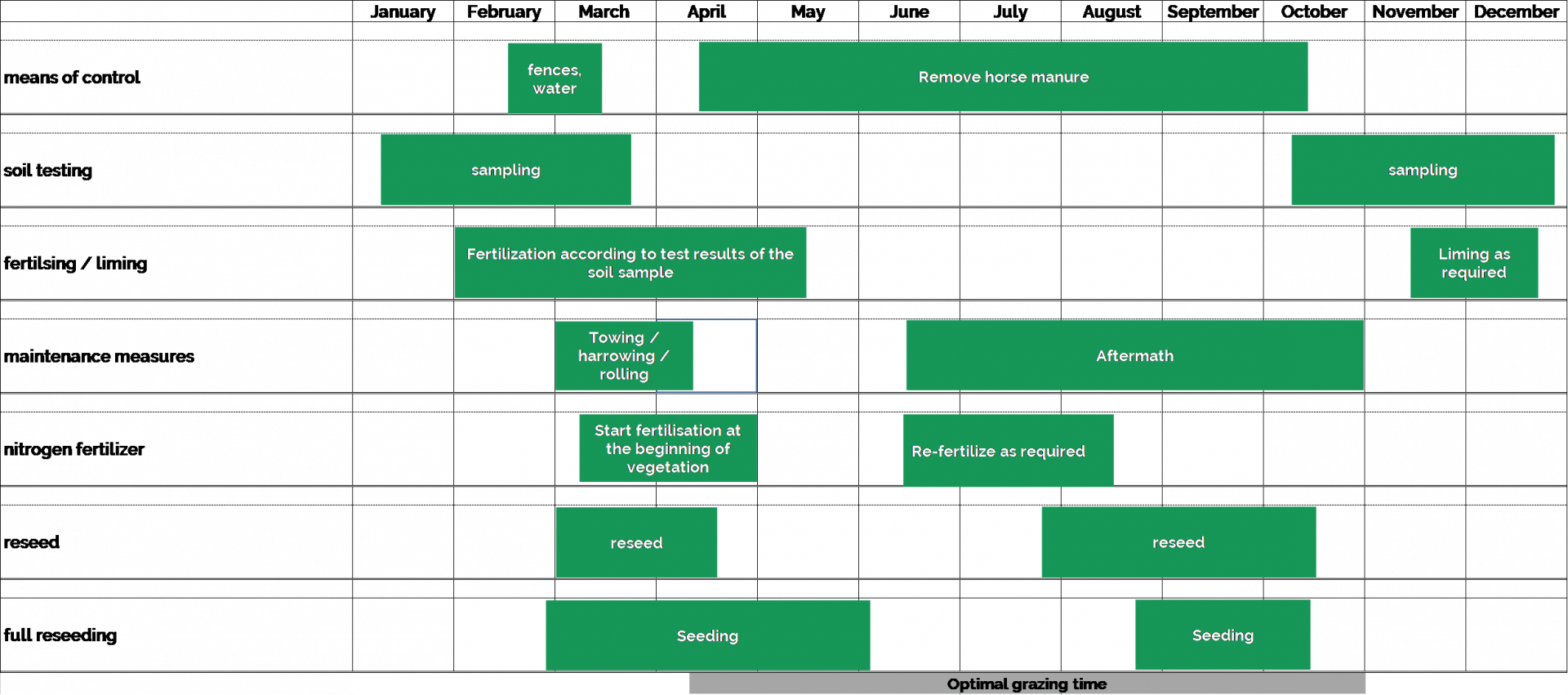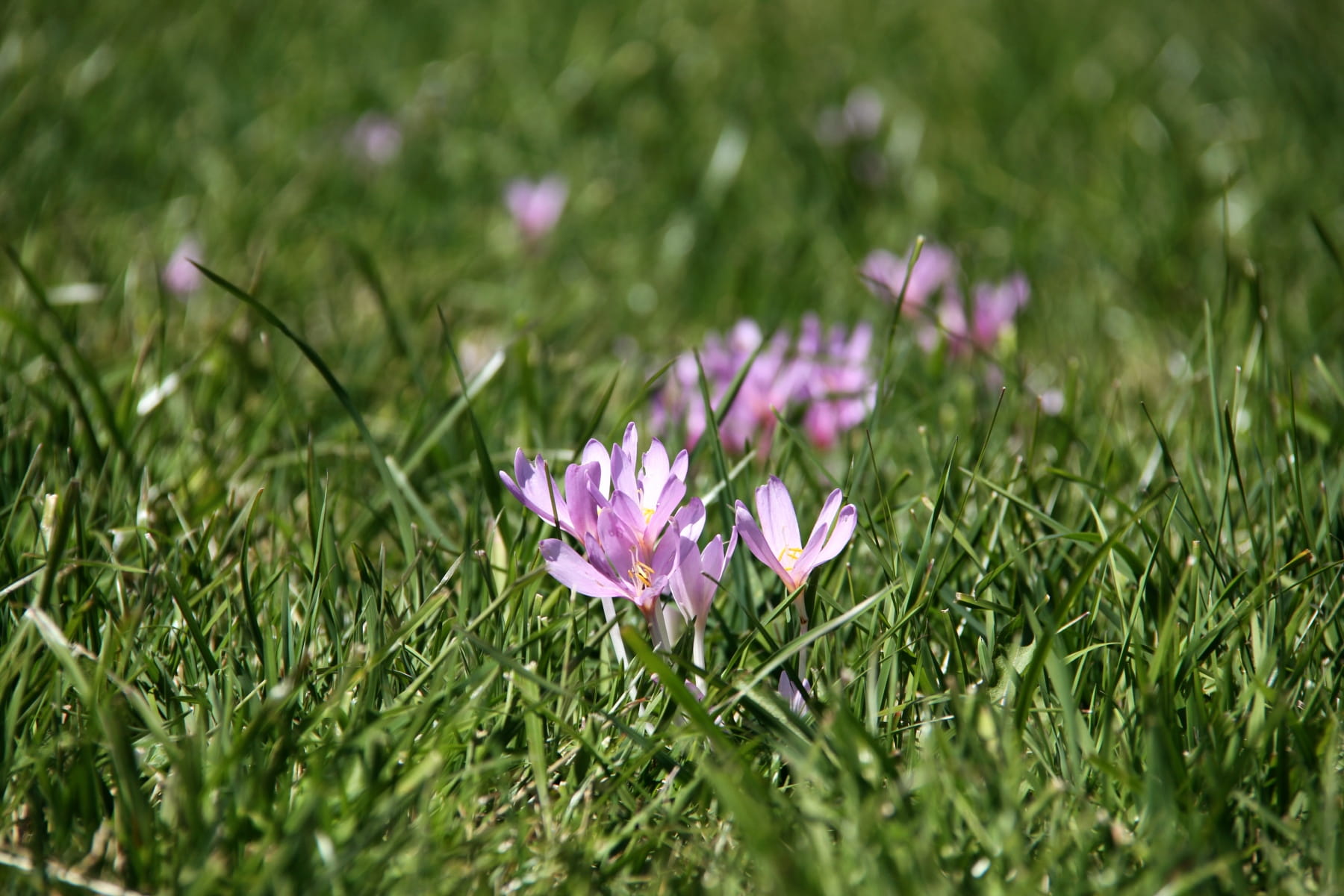
All about reseeding, overseeding and the right pasture maintenance
Is your pasture ready for the grazing season?
If we could ask our horses, they'd say they're ready. Ready to take in all that delicious, fresh grass they've been missing for so long.And yes, our pastures are green, but before we let our horses enjoy them, there are a few things that should be heeded.
1. Thinking a step ahead: soil analysis and fertilisation
Plants need nutrients to grow, which they get mainly from the soil through their roots. Soil analysis determines the presence and quantities of nutrients in a soil. Both inadequate and excessive fertilisation should be avoided, as these will have negative impacts on botanical composition and feed quality.A soil sample should ideally be taken between autumn and spring and sent to a lab or to your regional rural affairs authority. Analyses are carried out every three to four years, including for the basic nutrients phosphate, potassium and magnesium as well as for pH values. In addition to the current status of nutrient supply, the analysis also provides individualised fertilisation recommendations.
- The ideal pH value depends on the soil type, humus content and type of use, and affects the availability of nutrients. Because of this complexity, lime should not be added to the soil as a preventive measure.
- In the autumn and winter, sufficient rainfall will provide calcium carbonate to soils with too-low pH values. Magnesium carbonate lime is used on soils that are poor in magnesium.
Organic and mineral fertilisers provide nutrients that are important for plant growth: nitrogen (N), phosphorous (P) and potassium (K).
Organic fertilisers include slurry and manure. Their use on horse pastures must be viewed with some criticism: firstly because horses have extremely sensitive noses and secondly because such organic fertilisers are accompanied by parasites, increasing the risk of infections. Therefore, if horse manure is to be spread on horse pastures for agricultural reasons, it should be very well composted and distributed over the area in autumn, once every three years at most. Slurry is more suitable in terms of pasture hygiene.
The use of mineral fertilisers is more beneficial. If needed, nitrogen can be applied at the beginning of the vegetation period to promote plant growth, and the horses can be turned out after three weeks. Fast acting N fertilisers include calcium ammonium nitrate (CAN) and ammonium sulphate nitrate (ASN). Tall grasses benefit from these especially, however it's the short grasses that should be promoted to maintain a stable and intact turf. Calcium cyanamide is a slow-acting N fertiliser and therefore the most suitable for horse pastures. In addition to the slow and continuous release of nitrogen, calcium cyanamide also has anti-parasitic, herbicidal and pH-boosting properties.
Also widely used are "NPK" fertilisers, which apply nitrogen, phosphorus and potassium simultaneously. Their only disadvantage is the predetermined composition, which does not fully address individual site conditions.
- When fertilising with nitrogen and phosphorous, observe government regulations and blocking periods
- Apply mineral fertilisers ideally in early spring (March - April) at the beginning of the growth period.
- The turf should be dry whilst the soil should be sufficiently moist.
- May – August: reapply fertiliser according to need and weather
- Fertilisation with nitrogen can influence fructan levels in grass: plants with a good supply of nitrogen store fewer fructans.
2. Pasture maintenance year round
Horse pastures must be able to withstand enormous loads. The grass is subjected to stress not only from the treading of horses; the deep biting typical of horses also stresses the turf and can contribute to the formation of bare patches, which in turn can lead to the proliferation of undesired plants. Horses do not graze at rank patches, i.e. areas where they defecate and urinate. This leads to selectively higher nutrient deposits at those places. Poor pasture hygiene increases the risk of infection from parasites. If possible, field use should be alternated between mowing and grazing.The most important maintenance measures (in spring) include:
- No turnout to wet pastures

- Remove horse manure year round: This prevents the formation of rank patches and promotes good pasture hygiene (parasite management)
- Dragging: Evens out uneven surfaces such as mole hills and hollows created by animal hooves.
- Harrowing: Stimulates grass growth through aeration. This also removes dead vegetation and weeds such as rough meadow-grass (reseed any resulting bare patches)
- Rolling: Creates soil cohesion, ensures a dense grass cover and improves water and heat conduction in the soil. Do not roll soils that are too wet or too dry.
- Fertilising: Basic fertilisation according to the results of your soil sample, as well as targeted nitrogen application at the beginning of the growth period and, if necessary, for the second growth cycle. Do apply further nitrogen fertiliser after the end of the grazing/growing season.
- Overseeding: Scatter seeds over areas where the grass cover is thin. Overseed problematic sites to help maintain the existing turf. Important: follow with rolling to press the seeds into the soil. A fertiliser spreader can be used for this. Smaller areas can be fertilised with a manual spreader or by hand.
- Overseeding/reseeding: To improve areas with large patches of damaged turf through the use of special tools. Important: The existing grass should be short before seeding (mow to 5-6 cm) and rolled afterwards. The seeds need moisture, light and air. About three weeks later, or when the plants reach a height of 15 cm, do a topping to keep the old grass short and stimulate young plant growth. The area should not be grazed for at least 6 (or better 8) weeks to protect the new seed.
- Full reseeding: Should only be carried out if there are hardly any valuable forage plants left and the turf is therefore no longer worth preserving. Full reseeding is not only more costly, it also requires more time and maintenance. The old turf must be killed by applying herbicides beforehand. After seeding, maintenance is crucial. Topping from a first growth height of about 15 cm. Reseeding may be necessary depending on growth development and site conditions. Seeding time may vary greatly, depending on the location, usually in spring until May or in late summer.
- Second-growth mowing/mulching: After grazing and at the end of the grazing season to remove excess growth, undesired plants and rank patches. This also prevents weeds and stimulates the continued growth of valuable short grasses. The average height should be at least 5-7 cm. Large quantities of cuttings should be removed.

3. Detecting and combating weeds year round
Horse pastures can be very susceptible to weeds. The reasons for this include horses' highly selective feeding behaviours and the high level of mechanical stress on the turf.Typical weeds (some of which can be fatally poisonous): 

• bitter dock
• thistle
• nettle
• hedge bedstraw
• meadow buttercup and creeping buttercup
• rattle
• marsh horsetail
• ragworts (especially common ragwort and marsh ragwort)
• autumn crocus
• thistle
• nettle
• hedge bedstraw
• meadow buttercup and creeping buttercup
• rattle
• marsh horsetail
• ragworts (especially common ragwort and marsh ragwort)
• autumn crocus
A well-cultivated and maintained intact turf (see 2) is the best way to prevent weeds. Sufficient recovery periods should also be planned to allow the turf to develop adequate bio-assimilation areas (i.e. that leaf mass is great enough to maintain photosynthesis) and for the plants to be able to store reserve nutrients. Weeds will have difficulty establishing themselves when the grass cover is able to regenerate.
The use of herbicides should be a last resort for combating weeds. Specific individual plant control is recommended in order to protect the desired plants.
4. Valuable plant species for horse pastures
Grasses 
- Tall grasses: meadow fescue, meadow foxtail, timothy-grass, cock’s foot, false oat-grass
- Short grasses: English ryegrass, red fescue, Kentucky bluegrass, crested dog's tail
Leguminosae
- white clover, tufted vetch, bush vetch, meadow vetchling, red clover
Herbs
- burnet, meadow parsnip, wild carrot, yarrow, lamb’s tongue, dandelion leaf, chicory, caraway
5. Indicator plants
Assessing pasture condition requires a good familiarity with plant species. So-called "indicator plants" are helpful in determining errors in a pasture's management and assessing its properties.Overgrazing = over-exploited turf due to too little grazing area, inadequate recovery periods and high animal density. One often sees an increase in animal tracks as well as robust plant species that are trample- and bite-resistant.
Undergrazing = too much pasture offered, so that horses very selectively eat tastier grasses and herbs and avoid others. As these uneaten plants mature, flower and go to seed, they lose their nutrient value. Maturing also makes it easier for them to spread.
Examples:
| Overgrazing/ soil compaction | Undergrazing | Indicators for insufficient | Indicators for excess nutrients | Stop-gap species | |
| creeping thistle | X | ||||
| bracken | X | ||||
| comfrey | X | ||||
| broadleaf plantain | X | ||||
| nettle | X | ||||
| lady's bedstraw | X | ||||
| speedwell | X | ||||
| cat's ear | X | ||||
| daisy | X | ||||
| rough meadow-grass | X | X | |||
| bladder campion | X | ||||
| capsella | X | X | |||
| annual meadow-grass | X | X | |||
| rattle | X | X | X | ||
| curly dock | X | X | |||
| creeping buttercup | X | X | |||
| dandelion leaf | X | X | |||
| couch grass | X | X | |||
| tufted hair grass | X | ||||
| hornwort | X | ||||
| sheep's fescue | X | ||||
| bitter dock | X | X | X | ||
| marsh thistle | X | ||||
| common knotgrass | X | ||||
| chickweed | X | ||||
| soft brome | X | ||||
| creeping soft grass | X | ||||
| white nettle | X | ||||
| creeping bentgrass | X | ||||
| white clover | X | ||||
| hogweed | X | ||||
| ox-eye daisy | X | ||||
| quaking grass | X |
6. Why promote plant diversity?
Only intact and diligently maintained horse pastures are good sources of food with adequate space for equine exercise. Many horse pastures had previously been used as farmland and are therefore lacking in biodiversity. These fields usually consist of English ryegrass, which has become increasingly unpopular amongst horse owners because it stores more fructans than other types of grass. Fructans are frequently associated with metabolic diseases and laminitis. Nevertheless, English ryegrass is an indispensable component of a dense and robust grass cover, therefore cultivated breeds of English ryegrass with lower fructan levels can be used for reseeding. This is because the fructan content of grass is not only determined by its botanical composition, but also by other factors such as fertilisation, intensity of use, time of day and season. In addition to fructan content, epichloe fungi are also an issue: fungi living in endophytic symbiosis with grasses which are capable of producing toxins or alkaloids. These in turn can be harmful to the health of grazing horses. This symbiosis is very beneficial to the grasses, as they are more robust in the face of adverse environmental conditions and predatory herbivores. Amongst the various types of grass, English ryegrass in particular is infected with such fungi.
Nevertheless, English ryegrass is an indispensable component of a dense and robust grass cover, therefore cultivated breeds of English ryegrass with lower fructan levels can be used for reseeding. This is because the fructan content of grass is not only determined by its botanical composition, but also by other factors such as fertilisation, intensity of use, time of day and season. In addition to fructan content, epichloe fungi are also an issue: fungi living in endophytic symbiosis with grasses which are capable of producing toxins or alkaloids. These in turn can be harmful to the health of grazing horses. This symbiosis is very beneficial to the grasses, as they are more robust in the face of adverse environmental conditions and predatory herbivores. Amongst the various types of grass, English ryegrass in particular is infected with such fungi.Although one study has shown that the English ryegrass growing here in Germany lacks the starting gene for the production of ergovaline, the primary goal of any maintenance measure should nevertheless be to make pastures as biodiverse as possible in order to maintain a healthy forage base.
7. Sowingdata of our products
| Product | Pre Alpin® Saatgut |
Pferdeweide Sensitiv |
Kräutermix |
| Seeding levels new seeding | 30 kg/ha | 40 kg/ha | / |
| Seeding levels reseeding |
10 kg/ha | 10–20 kg/ha | 1-2 kg/ha |
| Seeding period | early spring or fall | early spring or fall | early spring or fall |
| Sowing depth | approximately 1cm | approximately 1cm | approximately 1cm |
| Longevity | perennial | perennial | perennial |
Daniela Hanke, Bsc. Agriculture Sciences
April 2020, © AGROBS GmbH
April 2020, © AGROBS GmbH
Sources*:
- Bayerische Landesanstalt für Landwirtschaft (2013): Pferdeweiden – Nutzung, Pflege und Düngung, 3. Auflage 2013, DOI: https://lfl.bayern.de/mam/cms07/publikationen/daten/informationen/p_36811.pdf
- Bayerische Landesanstalt für Landwirtschaft: Führung und Verbesserung von Grünlandbeständen, DOI: https://www.lfl.bayern.de/ipz/gruenland/025117/index.php
- Elsässer, M. (2003): Pferdeweiden Anforderungen –Maßnahmen – Pflege, Merkblätter für die umweltgerechte Landbewirtschaftung, Nr. 17 (2) Grünland, Weiden, Düngung
- Coenen, M.; Vervuert I. (2020): Pferdefütterung, Georg Thieme Verlag KG, Stuttgart
- Bender, I. (2013): Praxishandbuch Pferdeweide, 4. überarbeitete Auflage, Kosmos Verlag, Stuttgart
- Klapp, E.; Opitz von Boberfeld, W. (2013): Taschenbuch der Gräser, 13. überarbeitete Auflage, Eugen Ulmer Verlag
- Vikuk, V.; Young, C.A.; Lee, S.T.; Nagabhyru, P.; Krischke, M.; Mueller, M.J.; Krauss, J. (2019): Infection rates and alkaloid patterns of differentgrass species with systemic Epichloë endophytes. Appl Environ Microbiol 85:e00465-19. https://doi.org/10.1128/AEM.00465-19
(* The sources refer to the content of the text and not to the product recommendations)



